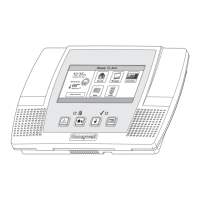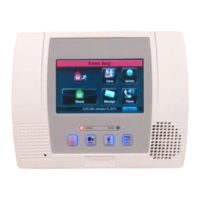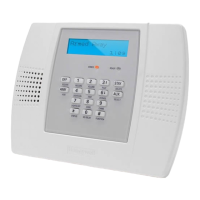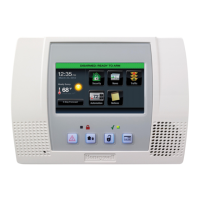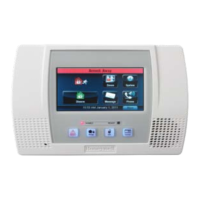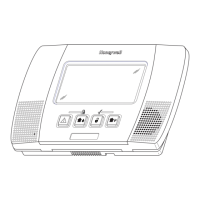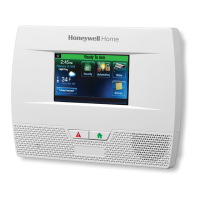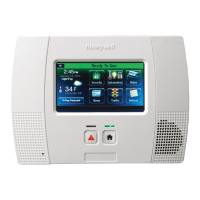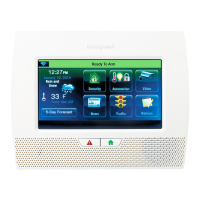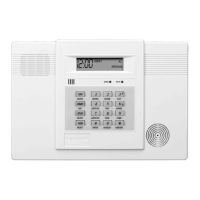Lynx Plus Series Installation and Setup Guide
- 13 -
Installing Wireless Zones
General Information
Zones: The control supports up to 24 wireless zones using 5800 Series transmitters, and up to 16 wireless
buttons.
Range: The built-in RF receiver can detect signals from wireless transmitters within a nominal range of
200 feet.
Transmitters: 5800 Series transmitters have built-in serial numbers that must be entered into the
system using the ✻56 or ✻83 interactive mode, or input to the control via the downloader. 5800 Series
transmitters (except the 5800RL, which is described separately) do not have DIP switches. Each
transmitter's zone number is programmed into the system in ✻56 mode. Some transmitters, such as the
5816 and 5817, can support more than one "zone" (referred to as loops or inputs). On the 5816, for
example, the wire connection terminal block is loop 1; the reed contact is loop 2. Each loop must be
assigned a different zone number.
UL
ULUL
UL
The 5816 and 5817 Transmitters do not have EOL supervision of their loop wiring and the loop wiring must
not exceed 3 feet.
The 5800RL, 5802MN, 5802MN2, 5804, 5804BD, 5804BDV, 5804E, 5814, 5816TEMP, 5819, 5819S(WHS &
BRS), 5828/5828V and 5850(GBD) transmitters have not been evaluated by UL.
For button transmitters (RF "keys") such as the 5804 and 5801, you must assign a unique zone number to
each individual button used on the transmitter. Each button on the transmitter also has a pre-designated
loop or input number, which is automatically displayed.
House Identification
If you are using a 5804BD/5804BDV Wireless Keypad with the system, you must program a House ID
Code (01–31) in field ✻24 to establish proper communication, and the keypad must be set to the same ID.
House ID 00 disables all wireless keypads. An RF House ID is not necessary for other 5800 Series
transmitters; the entry should be left at “00” (default) in those cases.
Transmitter Supervision
Except for some transmitters/keypads that may be carried off-premises (5804, 5804BD, 5804BDV, and
5804E), each transmitter is supervised by a check-in signal that is sent to the receiver at 70–90 minute
intervals. If at least one check-in is not received from each supervised transmitter within a 12-hour period,
the "missing" transmitter number(s) and "FAULT" will be displayed. Additionally, the panel will beep once
every 45 seconds until acknowledged. The supervision for a particular transmitter in the system that may
also be carried off the premises (5801, 5802MN) may be turned off by entering it as a "UR" (unsupervised
RF) type, as described in the ✻56 Enhanced Zone Programming Mode section. 5800 Series transmitters
have built-in tamper protection and dependant on system status, will annunciate as a fault or alarm
condition if covers are removed.
Transmitter Input Types
Each of the following transmitters has one or more unique factory-assigned input (loop) ID codes. Each of
the inputs requires a programming zone
(e.g., a 5804's four inputs require four button zones). Transmitters can
be entered as one of the following types
(see transmitter’s instructions for appropriate input type):
Type Description
"RF" (Supervised RF)
Sends periodic check-in signals, as well as fault, restore, and low battery signals.
The transmitter must remain within the receiver's range.
"UR" (Unsupervised RF)
Sends all the signals that the "RF" type does, but the control does not supervise the
check-in signals. The transmitter may therefore be carried off-premises.
"BR" (Unsupervised Button RF)
These only send fault signals. They do not send low battery signals until they are
activated. The transmitter may be carried off-premises.
Transmitter Battery Life
• Batteries in the wireless transmitters may last from 4–7 years, depending on the environment, usage,
and the specific wireless device being used. Factors such as humidity, high or low temperatures, as well
as large swings in temperature may all reduce the actual battery life in a given installation. The wireless
system can identify a true low battery situation, thus allowing the dealer or user of the system time to
arrange a change of battery and maintain protection for that point within the system.
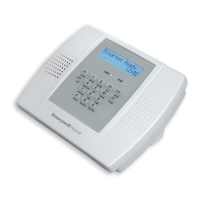
